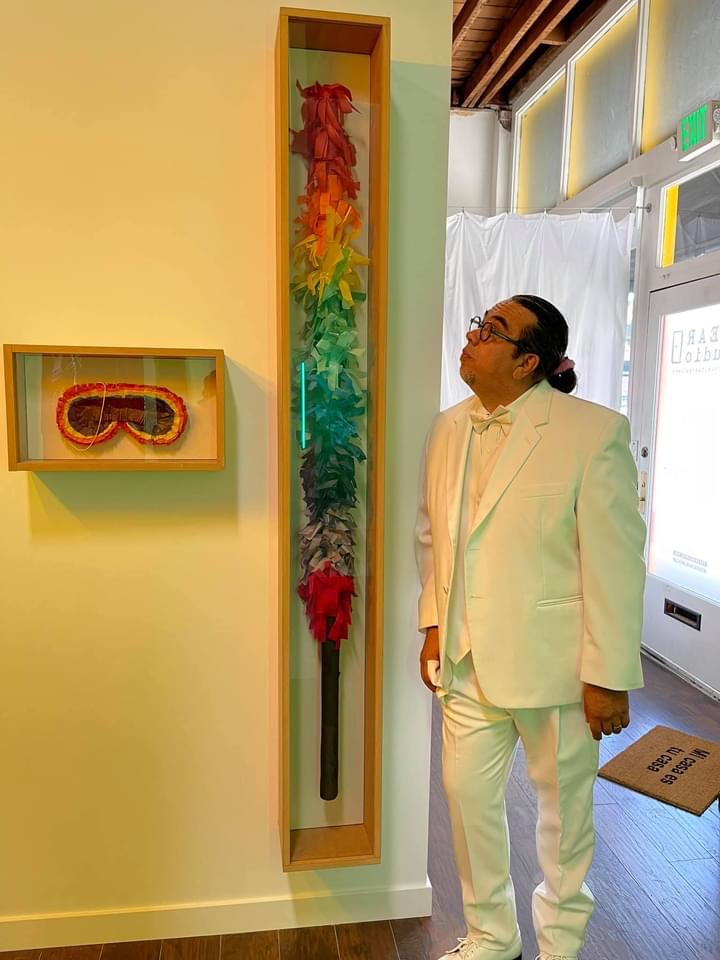
21 Jan Artist Interview: Albert Lopez, Jr.
By Walpa D’Mark
I attended Albert Lopez Jr’s show at Crear Studio on September 4, 2021. It might seem like it’s a little too late to be talking about it, but the exhibition had many layers, and eventually it led me to think about Albert’s creative process. Full disclosure, I know Albert, we both attended Cal State Long Beach in the late 90’s, and I worked for him at OCMA in the 2010’s.
Albert’s show at Crear Studio, titled “The Dollar Dance I Never Had!” featured works from different periods of the Artists career, and felt like a hybrid mid-career retrospective and home coming celebration all wrapped into one. Before this Solo show, he had never exhibited in his hometown of Santa Ana, so Crear Studios did well in choosing him as their inaugural exhibition.

On the opening night, as I walked towards the gallery, a crowd of onlookers were chatting and looking into the large gallery windows. A small line formed out of the front door. When I got to the window I saw Albert in the middle of the gallery space, in front of the back wall, dressed in an elaborate white tux that had dollars pinned to it. I searched my wallet to make sure I had money to add to the tux. He was dancing with a patron, they were holding hands, each wearing masks, and divided by yellow plastic sheeting that hung from the ceiling. They were both between 2 more plastic sheets, behind the patron a red sheet, and behind Albert a yellow sheet. This little space brought the dancers together making the experience intimate, but it also emphasized them as the focal points in the gallery. It was still the middle of the pandemic, but people were getting vaccinated, so it was strange but also assuring to see people dancing. I heard the muddled music through the window, saw that Albert and guest were smiling having a good time as they danced and talked. Their dance came to an end, Albert thanked the patron and invited her to take a dollar from his tux.
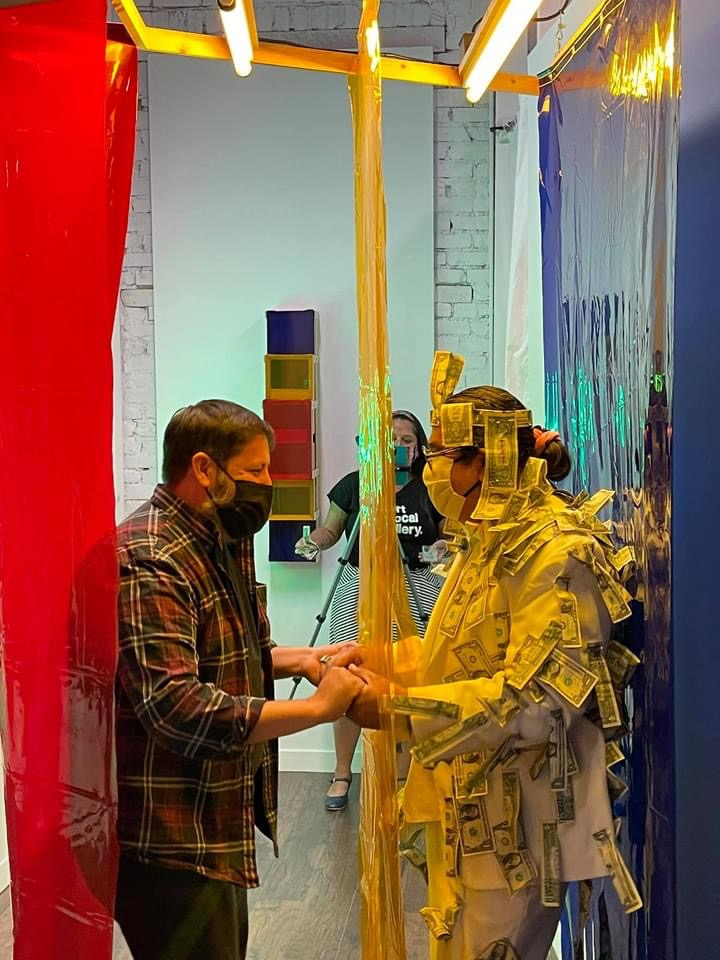
My friend, Hagop Najarian, was at the end of the line, so I joined him. We talked about the show and Albert, and admired the dancers as they went before us. When my time came to dance with Albert, I had two left feet, but it didn’t matter. We danced, talked about our time at Cal State Long Beach, at OCMA, about our friendship, and about how time flies. I have to say, I was kind of sad, but in a good way, it was intimate. When we stopped dancing, he invited me to take a dollar that was pinned on his tux. I took it and went on my way, kind of feeling guilty that I took the dollar! It was Hagop’s fault. Being the great human that he is, Hagop actually gave him a dollar in return. I didn’t. I took the dollar home and put it on a small panel and hung it in my studio. And I thought about the dance as a performance piece, and realized that I was part of the performance. As time went by, I also realized that I was a recipient of the performance, and not just an active participant. We had spoken about our friendship as we danced, in other words, he had given me his attention, and he also gifted me a dollar in his Dollar Dance. Mind you, he gave me a dollar in his Santa Ana home coming, in the inaugural exhibition for Crear Studios. So, of course, the more I thought about it, the more poetic it became, but it also got me thinking about his work in general. I first knew him as a gifted painter, and I followed his transition into sculpture, and then into performance. To be frank, I was surprised when he abandoned painting at first, and was always interested in what he was up too, but this was the first time I participated in his performance. It got me thinking about how he evolved through his creative process. So, I asked him if he would chat with me about it, so we met on zoom as it is the fashionable thing to do now a days.
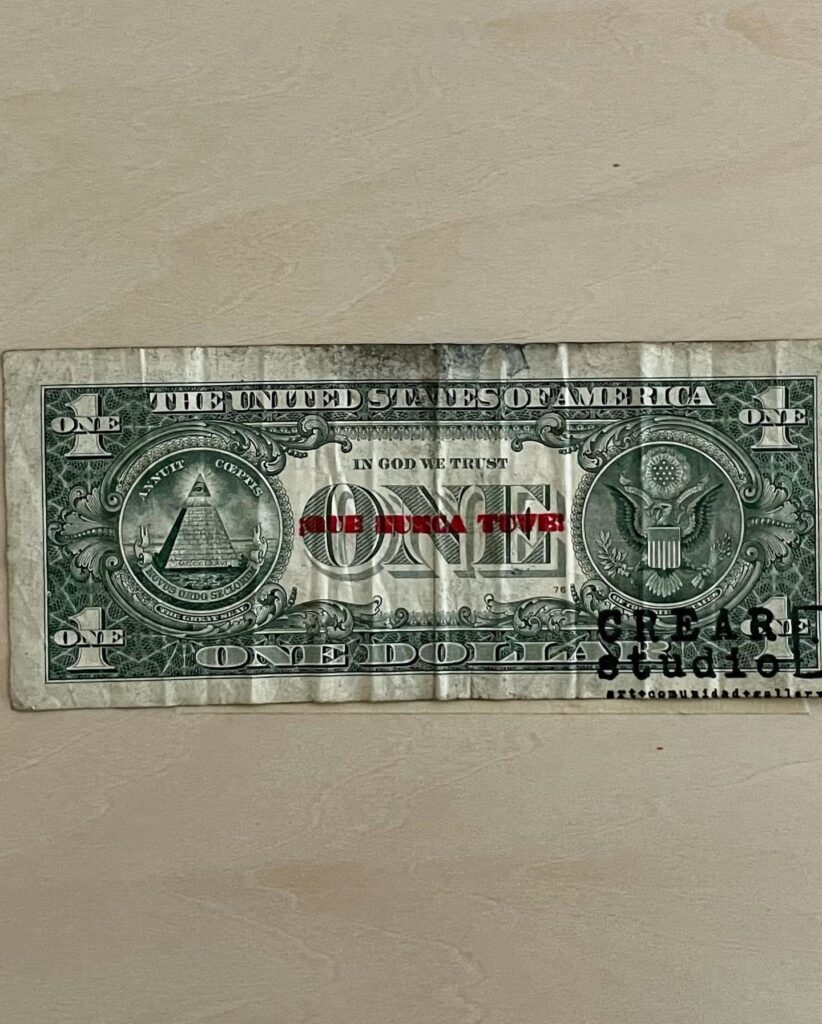
W: Hi Albert, I want to talk about your evolution from a painter to a sculptor and performance Artist. Can you tell us how and when you knew you were going to pursue Art?
A: I Decided to be an Artist when I was attending community college. As first generation, I was fortunate to have had the opportunity to go to college. I was always interested in the arts, but it was hard to choose that major, because I grew up hearing the narrative you won’t make money as an artist, so was discouraged to go into fine arts. As a student in community college, I knew that you can major in biomedical illustration at Cal State Long Beach, that seemed like an opportunity to study anatomy and drawing, be able to be in arts, and also have a career. That’s how I started at CSULB, and it blew up from there.
W: What were your interests as a student in the Fine Arts Program at CSULB?
A: Once in the program, I challenged myself to communicate ideas that were important to me. I began thinking about documenting and painting the people that were influential to my life, to highlight them. People in my family like my uncle and dad, the music around me, the language around me. For example, “Rompecabezas” was a symbolic gesture about being puzzled or confused as a first-generation artist or students, feeling that there’s no point of reference.
W: As a first generation Nicaraguan American and Artist, I know about that confusion. I could see you referencing yourself in your work at CSULB. When did the transition come into sculpture, and how?
A: I attended Grad school at UC Irvine. I began to get points of references through exposure to art history and theory, through understanding movements like arte povera, minimalism, and the Asco artist collective. I asked myself how I could be transparent and honest, and these new mediums gave me points of references to express what I was thinking. UCI gave me the freedom to think of myself as an interdisciplinary artist, and I became a well-rounded artist working in all those types of media. As a first gen artist, not coming from an arts background, when you have the opportunity to make art, you need to figure out how to contribute to the art world. Grad school allowed me to have freedom to create with conceptual clarity, rather than create confusion or ambiguity. Misinformation is easy to put out there, UCI allowed me to be clear about what I was trying to say.
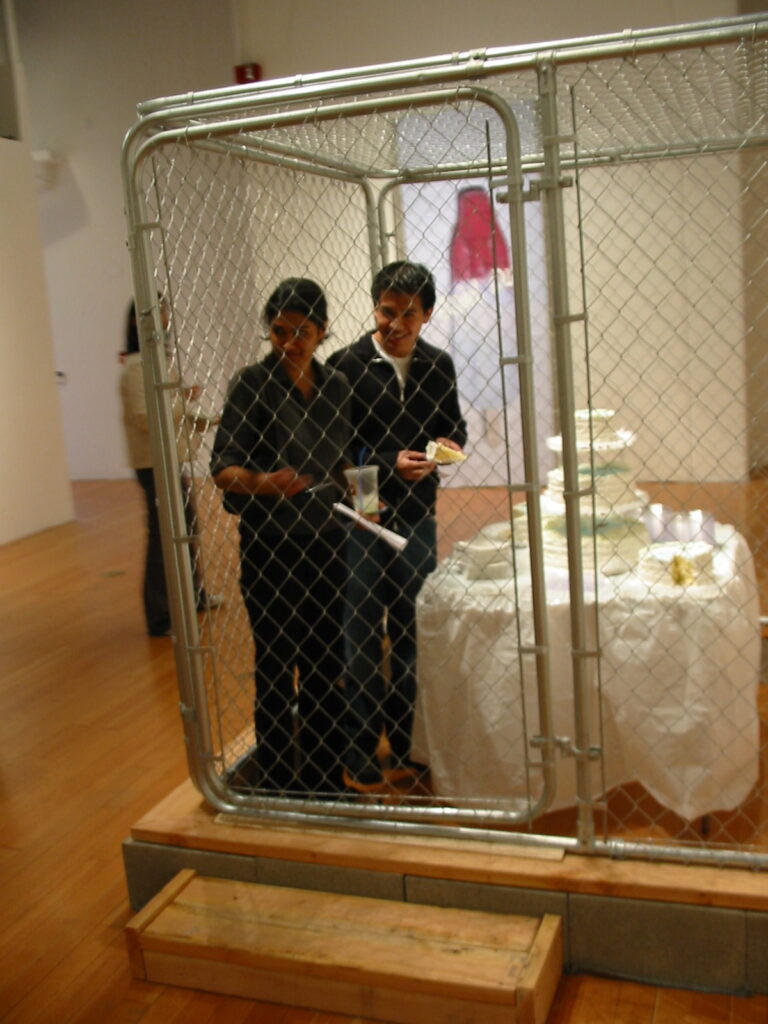
W: Can you give an example of work that helped you think about clarity while at UCI?
A: I made the Cake piece at UCI: I made an actual cake instead of painting a cake, because painting a cake is different from eating a cake. I put the cake inside a cage, so you can have your cake and eat it too, but you’re inside a cage. That was based on memories of desire I associate with the popsicle man in the community. There are popsicles involved, but there are also political issues where they’re trying to get rid of these types of businesses, these are ongoing issues. We saw it with Ruben Ochoa’s “Vendor.” These conversations have been going on for generations. We look at our American history and how we have been treated as people. Regardless of what I’m trying to do, I get involved again, people want to think of me as a social practice artist, but I don’t see myself that way, it’s not the initial reason why I make the work, I think the first reason is because I think it’s important, and after that it flushes itself out.
W: Do you think it’s important to talk about your personal life, what you think is important? At CSULB, you talked about family members, people that influenced you in your everyday life. In UCI, you’re starting to observe your broader community.
A: At UCI, I was thinking about what is contextually important to me, but I was still thinking about formalism and aesthetics, making things pleasing and beautiful. From there I tried to add the layers of identity and politics. People ask me all the time if I’m a Chicano Artist, and I ask myself, why do I have to be categorized liked that? The ideas are about who I am, and that’s part of who I am, but it’s not the only reason why I make Art.
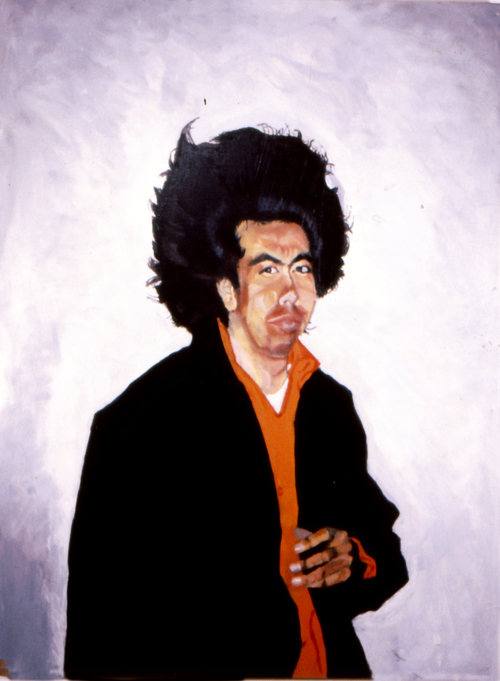
W: Why did you choose sculpture, minimalism and arte povera as your aesthetic?
A: I like the directness and clarity of minimalism, it’s really beautiful. I’m not interested in what Minimalism was doing contextually in the Artworld, but I think it’s a beautiful aesthetic. Arte Povera is counterintuitive to minimalism. It’s Art for the poor people, but it was still rich people who were making and buying it, so there’s that. But it did introduce counter culture to the high art community. I really like it for the use of industrial materials, of popular materials like dish towels, the symbolism of common materials. It’s interesting connecting the materialism of these aesthetic approaches to who I am. Also, the dances and performances I do in my work are from popular culture.
W: After thinking about your show at Crear Studio, I feel that one of your concerns is the idea of accessibility. Is it important for you to make your work accessible?
A: I do want it to be accessible; I want it to be a learning experience for people. I want it to be clear and genuine. It upsets me when artists’ exploit communities, it’s problematic because it’s exploiting other people’s misfortune. Does the artwork change the communities, do the artists’ give money to the communities? Are they helping to change the issues in those communities? Or is it only benefiting the Artists’ career? That’s what’s tricky about painting portraiture that have individual’s identities. That’s what’s interesting about sculpture, I feel like I could talk about identity without exploiting people’s identities. Without perpetuating the vicious cycle of exploitation, the toxic environment, toxic behavior, toxic relationship of power. The Dollar Dance at Crear Studio, it was important for me to give back, and to think about how people engage with artwork, it was important to be intimate with people. To think about the complexity of what you’re experiencing. Getting married, celebrating, the complexity of that. I want my work to be for a diverse audience. I think artwork needs to be made without financial gains in mind. Other things are more important. Slowing things down is important to me, it takes time to get things done. I want to be an example for generations to come to be patient, not be a part of what’s fashionable at the moment. We can be part of the diverse conversation about our communities. Being from Nicaragua is different from being from Jalisco, different from being born here. Identities are loaded and complex, and for me it is more important to talk about what is positive.
W: I have heard you talk about your van pulling piece (Jale: Class C, Mobile Gallery), and that it was not understood as Art by the onlookers. Did this performance inform your philosophy of accessibility?
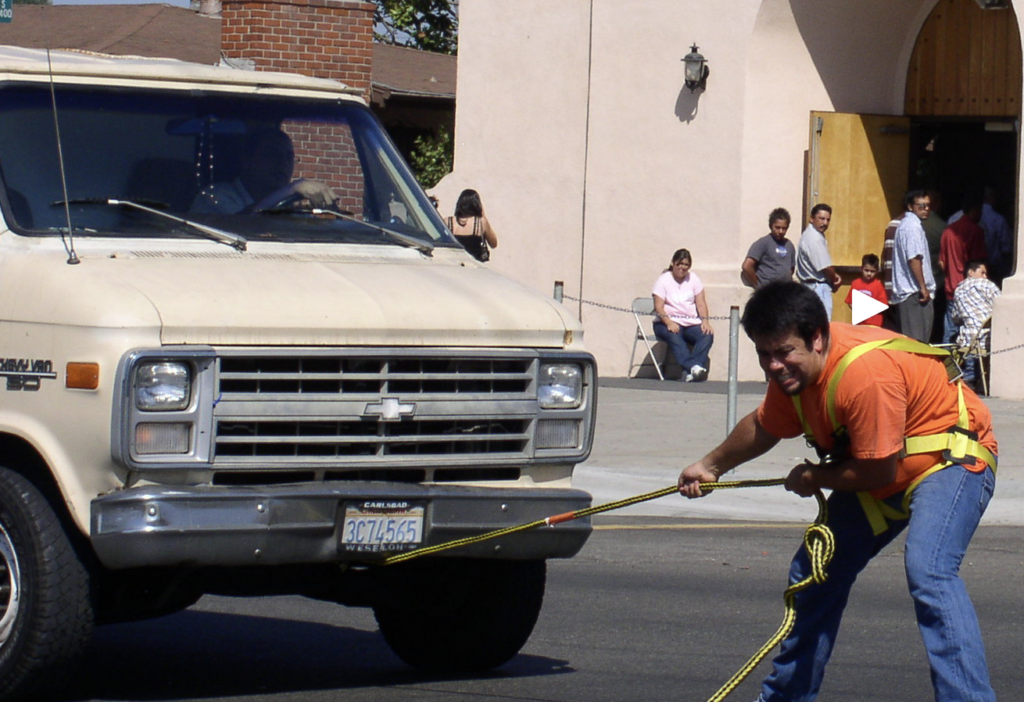
A: We think as artists when we make a piece, but we forget that not everybody is thinking about Art, and that it’s not fair to the viewer. I find myself in conflict with things socially and forget that it’s not like a dime a dozen Alberts out there in the community, Art is a niche community. Sometimes, I’ve found myself asking why didn’t they understand this?
I used the van as material to talk about this idea of community, In front of the church I grew up in, to look to your community for support. Looking back, I’m finding myself trying to have more empathy, thinking that we all have different experiences, not everybody has my experiences. I’ve learned to slow down and have more empathy.
W: I went to your show at Crear studio and it was familiar to me. The dollar dance was accessible because I have been in that scenario before. There was a difference though. Besides dancing, we were the recipient of your attention and the dollar. It wasn’t just a performance that the audience observes, like Jale: Class C, Mobile Gallery, or like a Rococo painting where there is a fourth wall dividing the viewer and the painting.
A: Yeah, I wanted to give back to people. I appreciate their time and willingness, its valuable to me, it’s intimacy within our own community. The dollar dance is popular among 1st gen immigrants, people are sometimes embarrassed or afraid of their traditions, I want to celebrate who they are.
W: The van piece was performance, the onlookers witnessed a spectacle but were separated from it. If they had interest in art they could start thinking about signifiers and symbolism. But in dollar dance, the looky loo’s are in the performance, and they are your focus, similar to “Tacos a la Microonda.”
A: With Jale: Class C, Mobile Gallery, there was a little bit of miscalculation on my part. I’m speaking a foreign language to some, so it was not fair. It was exploitative because I was the focus and I used them as a backdrop. It taught me about performance and engagement with community. It got me to my piece Mic Check, and to collaborating with people. And to talk a little about Tacos a la Microonda, while I was developing it, I thought about art in the renaissance. Art played a role in getting people invested in the church by making them use their senses. Think about the Sistine Chapel. Senses are very powerful, it evokes memory. Like tacos, the smell of carne asada, the taste of chile, the music, these senses evoke memories of community. Eating carne asada every weekend, that was our tradition, going to my grandma’s house, it was clear and honest and humble, everybody got the same and there was abundance.
-Mic Check: http://www.albertlopezjr.com/mic-check-old
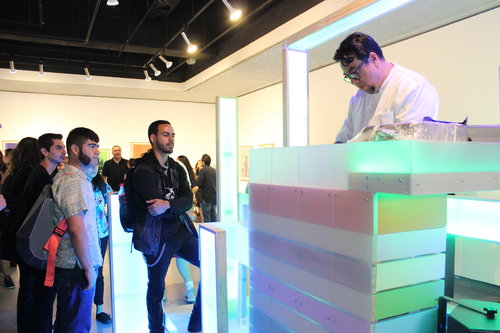
W: I like the idea that senses evoke memories. I like that my participation in the Dollar Dance did evoke my memories of weddings, of friends and family. I appreciate that Albert thought of each person as they danced the dollar dance with him, that he gave them his attention for that brief moment. And I genuinely understood when I received the dollar that there was abundance and enough for everyone.
Keep your senses open for upcoming solo exhibitions for Albert Lopez Jr in 2022, at S/A Exhibitions and at Cerritos College. Take a look at his work and information at Albertlopezjr.com



Sorry, the comment form is closed at this time.